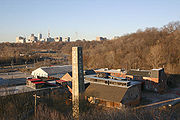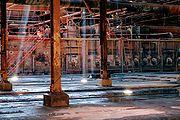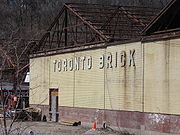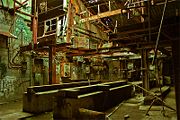
Don Valley Brick Works
Encyclopedia

Don River (Toronto)
The Don River is one of two rivers bounding the original settled area of Toronto, Ontario along the shore of Lake Ontario, the other being the Humber River to the west. The Don is formed from two rivers, the East and West Branches, that meet about north of Lake Ontario while flowing southward into...
valley in Toronto, Ontario. Currently the buildings sit mostly unused while the quarry has been converted into a city park which includes a series of naturalized ponds. The Don Valley Brick Works operated for nearly 100 years and provided bricks used to construct many well-known Toronto landmarks, such as Casa Loma
Casa Loma
Casa Loma is a Gothic Revival style house in midtown Toronto, Ontario, Canada, that is now a museum and landmark. It was originally a residence for financier Sir Henry Mill Pellatt. Casa Loma was constructed over a three-year period from 1911–1914. The architect of the mansion was E. J...
, Osgoode Hall
Osgoode Hall
Osgoode Hall is a landmark building in downtown Toronto constructed between 1829 and 1832 in the late Georgian Palladian and Neoclassical styles. It houses the Ontario Court of Appeal, the Divisional Court of the Superior Court of Justice, and the Law Society of Upper Canada...
, Massey Hall
Massey Hall
Massey Hall is a venerable performing arts theatre in the Garden District of downtown Toronto. The theatre originally was designed to seat 3,500 patrons but, after extensive renovations in the 1940s, now seats up to 2,765....
, and the Ontario Legislature. The buildings are currently undergoing restoration, courtesy of Evergreen, a national charity dedicated to restoring nature in urban environments.
History

The Don Valley Pressed Brick Company produced bricks using three techniques. The first was called a soft-mud process. Clay quarried from the site was mixed with water from nearby Mud Creek, placed in moulds which were dried and then baked in kilns. A second technique called dry-press bricks used quarried shale. The shale was placed into moulds and machine pressed. A third process called stiff-mud used a mixture of clay and shale that used less water than the soft-mud process. A column of clay was forced through a die
Die (manufacturing)
A die is a specialized tool used in manufacturing industries to cut or shape material using a press. Like molds, dies are generally customized to the item they are used to create...
which was then cut to form using a wire. Finished product was shipped by cart out of the valley along Pottery Road or by rail on a spur built into the yard. Bricks were used mostly in Toronto but were used across the continent. The bricks made were of such good quality that they won prizes at the Chicago World's Fair in 1893 and the Toronto Industrial Fair in 1894.
In 1893, the company added a continuous down-draft kiln which increased the quality and amount of bricks produced. By 1907 the company had two of these kilns in operation and was producing between 85,000 to 100,000 bricks per day.
In 1909, the Taylors sold the company to Robert Davies
Robert T. Davies
Robert T. Davies was a Canadian businessman and Thoroughbred and Standardbred racehorse owner and breeder.Born in Toronto, Ontario, he studied at Park School and Upper Canada College, in the early 1870s Robert Davies married Margaret Anne Taylor, the daughter of John Taylor, owner of paper mills...
(a brother-in-law). Davies changed the name to the Don Valley Brick Company Limited. In the 1920s a major expansion resulted in a name change to the Don Valley Brick Works Limited. Electricity was added and a new sand-lime plant was added that created a less expensive brick used for interior construction. In 1928, the company was sold to Strathgowan Investments and was renamed again to the Toronto Brick Company. At this time the company had reached peak production of about 25 million bricks per year.

World War II
World War II, or the Second World War , was a global conflict lasting from 1939 to 1945, involving most of the world's nations—including all of the great powers—eventually forming two opposing military alliances: the Allies and the Axis...
, production was reduced. The plant used German
Germany
Germany , officially the Federal Republic of Germany , is a federal parliamentary republic in Europe. The country consists of 16 states while the capital and largest city is Berlin. Germany covers an area of 357,021 km2 and has a largely temperate seasonal climate...
prisoners of war
Prisoner of war
A prisoner of war or enemy prisoner of war is a person, whether civilian or combatant, who is held in custody by an enemy power during or immediately after an armed conflict...
that were housed at nearby Todmorden Mills
Todmorden Mills
Todmorden Mills was a small settlement located in the Don River valley in Toronto, Ontario. It started out as a lumber mill in the 1790s. Originally known as "Don Mills", it grew into a small industrial complex and village before becoming part of East York in the 20th century...
. After the war a building boom revived demand. However, the sand-lime plant was destroyed by fire in 1946. Also the plant consolidated its outbuildings and three of the four signature chimneys were knocked down. Only one chimney remains today. The site underwent many changes during its existence, adding and removing buildings whenever and wherever it was condusive to the brick making process. The buildings, cluttered on the south end of the site, are all rectilinear buildings arranged in a grid-like pattern, connected wherever the users saw a need.
In 1956, United Ceramics Limited of Germany acquired the Brick Works. Over the next 25 years a new sand-lime plant was constructed. Also a Parkhill Martin Brick machine was moved from a nearby brick works to this site. It produced soft-mud bricks for the antique market. By the 1980s most of the usable clay and shale had been quarried. The company decided to offer the land to the city for $4 million CAD for conservation purposes. However, a company called Torvalley Associates offered $4,001,000 for the site and managed to purchase the site. The company had close links with East York city council and managed to convince them to rezone the land for a housing development.
The Toronto and Region Conservation Authority
Toronto and Region Conservation Authority
Toronto and Region Conservation Authority or Office de protection de la nature de Toronto et de la région is one of 36 conservation authorities in Ontario, Canada...
had final say on the matter since the site was partially on the floodplain of the valley. They expropriated the land in 1987 but were forced to pay approximately $14,000,000 since the land was zoned as residential. Another company, Brampton Brick leased the site and purchased the remaining equipment. They operated a retail outlet at the site until 1991.

Scotia Plaza
Scotia Plaza is a Postmodern commercial office complex in the city of Toronto, Ontario, Canada. The complex is situated in the financial district of the downtown core, and is generally bordered by Yonge Street on the east, King Street West on the south, Bay Street on the west, and Adelaide Street...
tower in downtown Toronto. Once filled, the site was landscaped to create a series of three ponds using water diverted from Mud Creek. The water flows out of the ponds into a channel that was used to divert water into the brick plant. The channel then flows underneath Bayview Avenue
Bayview Avenue
Bayview Avenue is a major north-south route in the Greater Toronto Area of Ontario. North of Toronto, in York Region, Bayview is also designated as York Regional Road 34.-History:...
and back into the Don River. The remaining area was turned into meadow. The shores of the ponds were planted with native trees, shrubs and wildflowers. The site was officially opened in 1997 and christened the Weston Quarry Gardens.
Currently, the site is being readapted by Evergreen, and environmentally conscious charity looking to make cities greener. The buildings, many of which are in disrepair, and being further restored. (see Future of the Brick Works below).
Since then, the site has attracted many species of birds and animals. Although no fish were stocked in the ponds, fish have migrated into the ponds from the Don River. The ponds have also become a dumping ground for goldfish and red-eared slider turtles that have outgrown their home terrariums.
Weston Quarry Garden

Mud Creek
There are hundreds of streams or places named Mud Creek, 881 of which are in the United States, according to the USGS GNIS.*Mud Creek tributary of the Angelina River*Mud Creek Glacier on California's Mount Shasta...
which flows just to the west of the Brick Works. Initially, the area adjacent to the ponds was planted with species native to Ontario. This also included some species that are not locally native including Tulip Tree, Fragrant Sumac
Sumac
Sumac is any one of approximately 250 species of flowering plants in the genus Rhus and related genera, in the family Anacardiaceae. Sumacs grow in subtropical and temperate regions throughout the world, especially in Africa and North America....
and Eastern Redbud
Eastern Redbud
Cercis canadensis L. is a large shrub or small tree native to eastern North America from Southern Ontario, Canada south to northern Florida, United States....
. These species are found only in areas along the north shore of Lake Erie. However the quarry basin of the Brick Works forms a warmer micro climate which allows these species to survive.
Once the wetlands became established, many species of birds have visited to forage or breed. Mammals, reptiles, amphibians, and some fish have also found their way to the Brick Works and have established themselves. This includes duck
Duck
Duck is the common name for a large number of species in the Anatidae family of birds, which also includes swans and geese. The ducks are divided among several subfamilies in the Anatidae family; they do not represent a monophyletic group but a form taxon, since swans and geese are not considered...
s, Canada Geese
Canada Goose
The Canada Goose is a wild goose belonging to the genus Branta, which is native to arctic and temperate regions of North America, having a black head and neck, white patches on the face, and a brownish-gray body....
, toad
Toad
A toad is any of a number of species of amphibians in the order Anura characterized by dry, leathery skin , short legs, and snoat-like parotoid glands...
s, muskrat
Muskrat
The muskrat , the only species in genus Ondatra, is a medium-sized semi-aquatic rodent native to North America, and introduced in parts of Europe, Asia, and South America. The muskrat is found in wetlands and is a very successful animal over a wide range of climates and habitats...
s, sparrow
Sparrow
The sparrows are a family of small passerine birds, Passeridae. They are also known as true sparrows, or Old World sparrows, names also used for a genus of the family, Passer...
s, and others.
The Brick Works wetland is connected to a number of other nature reserve areas via forest trail, and is part of a larger effort to reestablish the Don Valley
Don River (Toronto)
The Don River is one of two rivers bounding the original settled area of Toronto, Ontario along the shore of Lake Ontario, the other being the Humber River to the west. The Don is formed from two rivers, the East and West Branches, that meet about north of Lake Ontario while flowing southward into...
watershed
Drainage basin
A drainage basin is an extent or an area of land where surface water from rain and melting snow or ice converges to a single point, usually the exit of the basin, where the waters join another waterbody, such as a river, lake, reservoir, estuary, wetland, sea, or ocean...
.
This area was the site of a number of important geological
Geology
Geology is the science comprising the study of solid Earth, the rocks of which it is composed, and the processes by which it evolves. Geology gives insight into the history of the Earth, as it provides the primary evidence for plate tectonics, the evolutionary history of life, and past climates...
discoveries which provided information on the glacial history
Ice age
An ice age or, more precisely, glacial age, is a generic geological period of long-term reduction in the temperature of the Earth's surface and atmosphere, resulting in the presence or expansion of continental ice sheets, polar ice sheets and alpine glaciers...
of southern Ontario.
Future of the Brick Works
Evergreen, a Canadian non-profit organization whose activities have included stewardship of the Don Valley Brick Works site since 1997, plans to develop the abandoned buildings into a cultural centre with a focus on the environment. Evergreen will lease the "industrial pad" portion of the site from the Toronto Region and Conservation Authority to renovate several of the existing structures and construct one new building, to be called the Centre for Urban Sustainability. The goal of the scheme is adaptive reuse, where most of the buildings will be reinforced where needed and repurposed to house the new programming planned for the site. In this way, the site can be recycled as much as possible and the historical integrity of the Don Valley Brickworks can be maintained.Evergreen Brick Works will be an education centre addressing the themes of nature, culture and community. [...] [I]t will be a destination for families and individuals to enjoy a natural refuge, while sampling a rich offering of programs and services - from gardening workshops, heritage tours, and clay-making and organic food markets, to a retail nursery, demonstration gardens and leading-edge green design techniques. http://www.evergreen.ca/rethinkspace/?page_id=10
$20 million of the project's $55-million dollar budget has been pledged by the federal government under the Canada Strategic Infrastructure Fund, and the Province of Ontario has contributed an additional $10 million. The construction process began in November 2008.
The project, which is still underway, is a joint venture between Du Toit Allsopp Hiller Architects, Diamond and Schmitt Architects, and several other prominent firms. DTAH is responsible for the master planning scheme, while Diamond and Schmitt are the designers of the new "Centre for Urban Sustainability", which will also function as the Welcome Centre. Other programming for the site includes an art gallery, classrooms, plant nursery, art gallery, and offices space for Evergreen and other environmental organizations.
The grand opening of the Evergreen Brickworks took place September 28, 2010. The complex is now open to the public, with regular shuttle running everyday from Broadview Subway Station. Though the project is in phase II, and many buildings are still under construction, programming such as weekend farmer's markets and community yoga classes are already in place.
Restoration to the building include structural reinforcement, and replacement of material such as the current asbestos transite roofing in favour of a more effective, longer lasting material. Several of the buildings were left without roof cladding in order to create open air spaces, leaving the steel trusses visible. The building's red-brick masonry was preserved as much as possible, while interiors were renovated to update plumbing, life safety and mechanical systems, as outline in Evergreen's Master Plan Update 2007. Each building has programming set aside for it in DTAH's planning scheme, such that the project can continue to expand as funds become available. The only new building on the site, The Centre for Urban Sustainability, is currently being built, on the north-east end of the site, and Evergreen is continuing to work on merging the past and future pictures of the Don Valley Brickworks, while at the same time integrating it into the natural context which surrounds it.
See also
- Distillery District
- Doors Open TorontoDoors Open TorontoDoors Open Toronto, now in its 12th year, has evolved into a weekend festival that is recognized as one of Toronto's greatest cultural events....
- John Taylor (paper manufacturer)John Taylor (paper manufacturer)John Taylor was a Toronto area businessman and a pioneer in the pulp and paper industry.-Early life:The Taylor family immigrated to Upper Canada from England in 1821...
, the elder brother William and George Taylor

